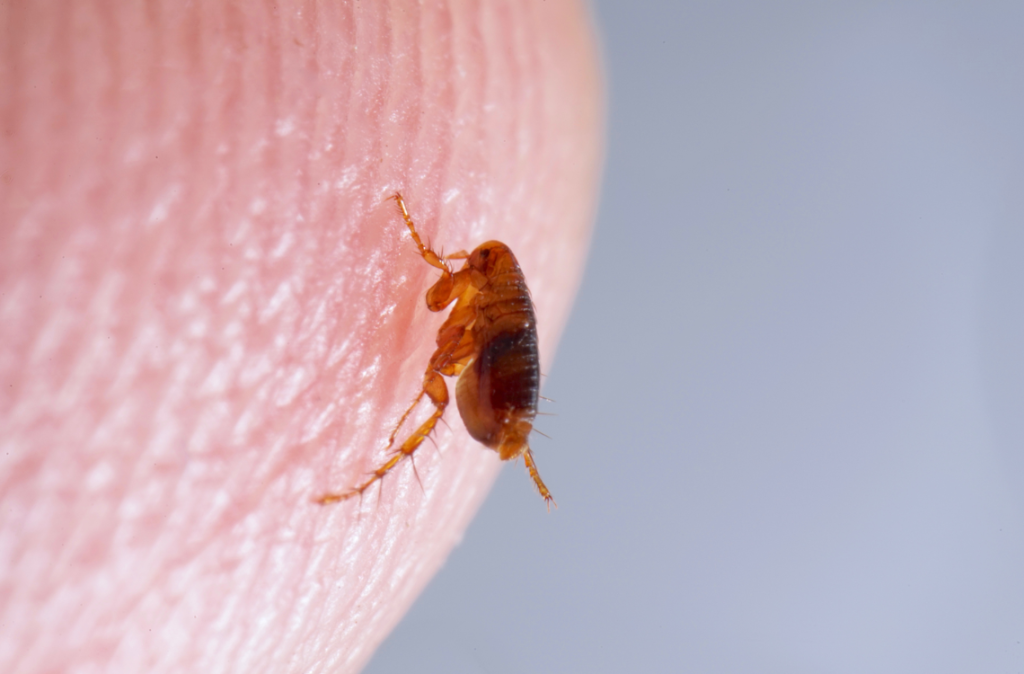Fleas, those seemingly insignificant, minuscule jumping insects, are a common nuisance for pet owners and, occasionally, those without furry companions.
While their tiny size might make them seem harmless, their bites can be far from it. Fleas are external parasites that have evolved to survive by feeding on the blood of mammals and birds, and their bites can cause significant discomfort, skin irritation, and even transmit diseases in some cases.
These resilient pests are adept at thriving in various environments, making them a persistent problem in many households.
Their life cycle consists of four stages: egg, larva, pupa, and adult. Adult fleas are the ones responsible for biting, as they need blood meals to reproduce.
Once a flea bites, it injects saliva into the skin, which can cause an immediate reaction in the form of itching, redness, and swelling.
The Sting of A Flea Bite
The hallmark symptom of a flea bite is intense itching, often an irresistible urge to scratch. The itching is caused by the body’s immune response to the flea’s saliva. Beyond the initial itch, you might notice redness, swelling, and even a rash-like appearance around the bite.
While these reactions are typically localised and subside within a few days, excessive scratching can lead to open sores and secondary infections.
In some individuals, flea bites trigger a more severe allergic reaction known as flea allergy dermatitis (FAD).
This condition can result in widespread skin inflammation, hair loss, and extreme discomfort for the affected animal or person.
It’s important to be aware of the signs of an allergic reaction and seek veterinary or medical attention if necessary.
Flea Bites and Disease Transmission
While the primary concern with flea bites is the discomfort they cause, it’s important to note that fleas can also transmit diseases. These include historically devastating illnesses like the plague, which, while rare today, is still present in some parts of the world.
Fleas can also transmit murine typhus, a bacterial infection that causes fever, headache, and rash, as well as cat scratch disease, which can lead to swollen lymph nodes and fever. In addition, fleas can carry tapeworm larvae, which can infect pets (and rarely humans) if accidentally ingested.
Finding Relief from the Itch
If you or your pet are dealing with the maddening itch of flea bites, there are several remedies available to provide relief:
Resist the Scratch
Resisting the urge to scratch is crucial, as it can break the skin, worsen irritation, and increase the risk of infection. Keeping nails short (for both humans and pets) can help minimise damage if scratching does occur.
Cleanse the Area
Washing the affected area with mild soap and water can help remove any irritants from the flea’s saliva and soothe the skin. Gently pat the area dry to avoid further irritation.
Cool and Soothe
Applying a cold compress, such as an ice pack wrapped in a towel or a cold washcloth, can help reduce swelling and numb the itch. The cold temperature helps constrict blood vessels, which can minimise inflammation.
Over-the-Counter Relief
Over-the-counter options like hydrocortisone cream or calamine lotion can provide temporary relief from itching and inflammation. These products work by calming the skin and reducing the body’s histamine response, which is responsible for the itching sensation.
Oral Antihistamines
In more severe cases or for individuals experiencing an allergic reaction, oral antihistamines may be necessary to alleviate the body’s histamine response and reduce itching. Always consult with a doctor or pharmacist before taking any over-the-counter medication.
Natural Remedies
For those seeking natural alternatives, a baking soda paste (made by mixing baking soda with water) or a lukewarm oatmeal bath can offer soothing relief for irritated skin. Baking soda has mild anti-inflammatory properties, while oatmeal is known for its ability to moisturise and soothe itchy skin.
Remember, these are just a few options for finding relief from flea bites. If the itching persists or worsens, or if you suspect an allergic reaction or infection, it’s important to consult with a healthcare professional or veterinarian for further guidance.
Preventing the Bite Before It Happens
Prevention is the most effective way to deal with flea bites. The best defense is a multi-pronged approach that includes regular flea prevention for your pets.
Talk to your veterinarian about the most suitable options for your furry friends, which may include spot-on treatments, oral medications, collars or shampoos.
In addition to pet treatments, maintaining a clean environment is crucial.
Regularly vacuuming areas where pets spend time, washing bedding in hot water, and even using natural deterrents like lavender or citronella oil can help keep fleas at bay.
For severe infestations, professional pest control may be necessary to eliminate fleas from your home or yard.
Living with Fleas
Flea bites are an unfortunate reality for many pet owners, but they don’t have to dominate your life or your pet’s.
By understanding how to identify and treat flea bites, you can minimise discomfort and reduce the risk of complications.
And by focusing on flea prevention through regular pet treatments, household cleaning, and other preventative strategies, you can keep these tiny pests at bay and enjoy a more comfortable and itch-free environment for both you and your furry companions.
Remember, if you have any concerns about flea bites or suspect that you or your pet may be experiencing an allergic reaction, don’t hesitate to seek professional medical or veterinary advice.
Disclaimer: The information provided in this article is for informational purposes only and should not be considered as medical advice from Mamahood. For any health-related concerns, it is advisable to consult with a qualified healthcare professional or medical practitioner.
For more insightful stories and parenting advice, stay tuned to Mamahood Singapore!
